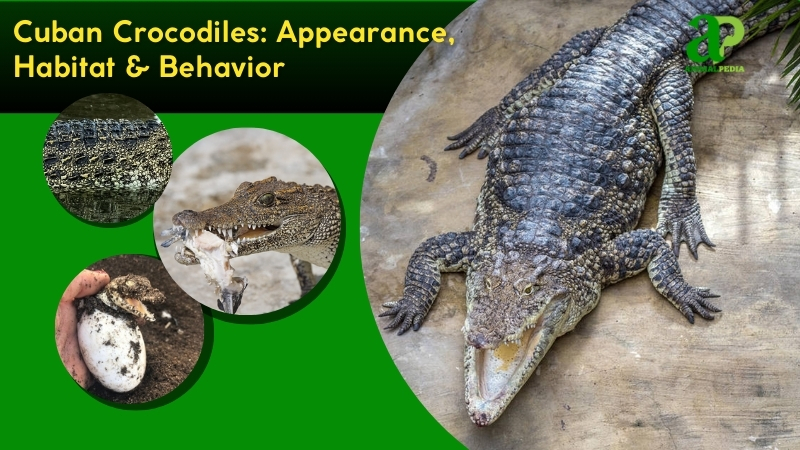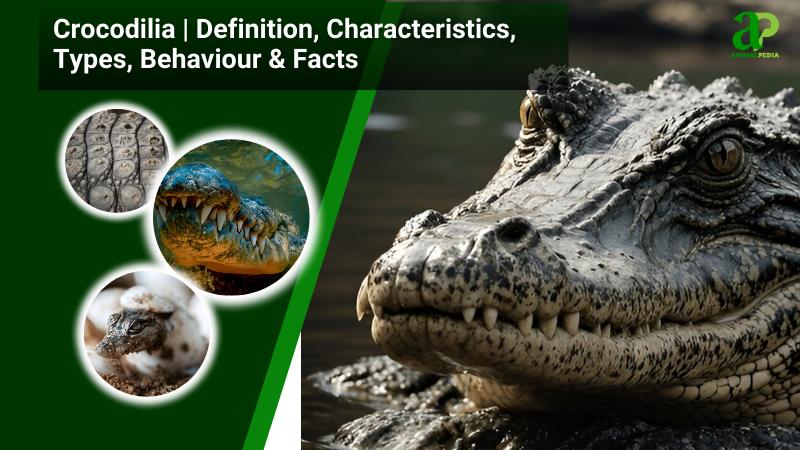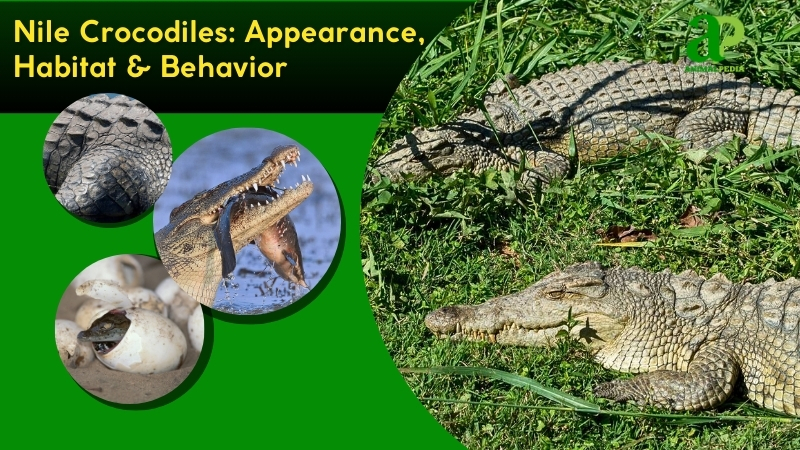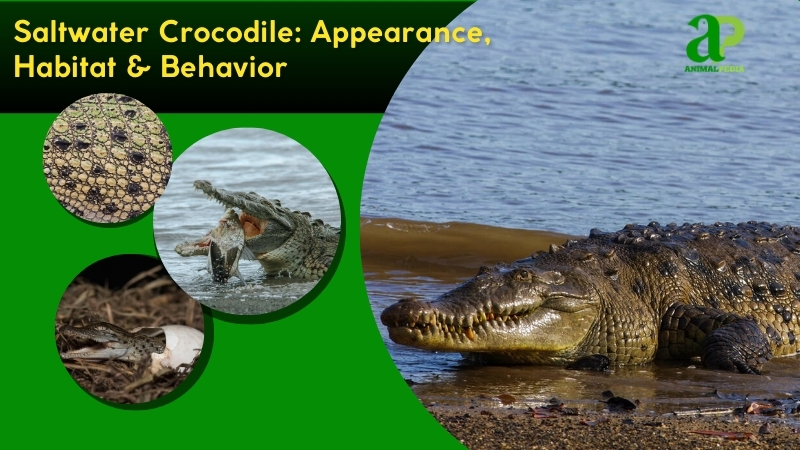The black caiman, Melanosuchus niger, a massive crocodilian, is named for its dark, slate-gray to near-black skin, ideal for nocturnal stealth. Black caiman size is its standout feature, reaching 13–20 feet (4–6 meters) and 400–1,100 pounds (181–500 kilograms), with males larger than females. It inhabits South America’s Amazon Basin, thriving in Brazil’s Rio Negro, Peru’s Madre de Dios, Guyana’s Rupununi River, and Bolivia’s Mamore Basin, favoring slow-moving rivers, oxbow lakes, and flooded forests.
As an apex predator, the black caiman rules its ecosystem. Black caimans hunt at night, using a 2,000-pound (907-kilogram) bite force to ambush prey like piranhas, catfish, capybaras, and occasionally deer or tapirs. Their diet specializes in large vertebrates, reflecting their dominance. Human interactions are rare but rise near fishing villages, where attacks, though uncommon, occur if caimans feel threatened.
Breeding begins in the dry season (November–April). Males emit deep bellows and perform head-slaps to court females, mating in shallow waters after synchronized swimming. Females lay 30–65 eggs, each weighing 0.2 pounds (90 grams), in mound nests of mud and vegetation along riverbanks, which they fiercely guard against predators like coatis.
Eggs incubate for 42–90 days, hatching in the wet season (May–October). Hatchlings, 12 inches (30 centimeters), face threats from jabiru storks, anacondas, and jaguars but are protected by females for 6–12 months. They grow 1 foot (30 centimeters) annually, reaching maturity at 10–15 years. Juveniles eat insects and small fish, transitioning to larger prey as they grow.
Black caimans live 50–80 years, with captives hitting 100. Their role as keystone species stabilizes wetland ecosystems, controlling prey populations. This article examines their appearance, habitat, predatory behavior, reproduction, and conservation, highlighting their ecological importance to Amazonian biodiversity and the need to address threats such as habitat loss.
This article explores the appearance, habitat, behavior, and conservation of black caimans, emphasizing their role as keystone species in Amazonian ecosystems.
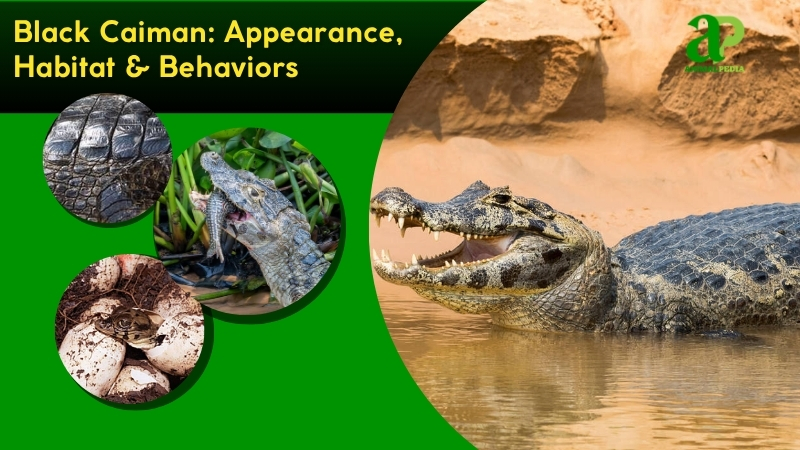
What Do The Black Caiman Look Like?
Black caimans have elongated, robust bodies, typically measuring 13–20 feet (4–6 meters) in length and weighing 400–1,100 pounds (181–500 kilograms). Their skin, covered in bony osteoderms, is rough and scaly, with a dark slate-gray to near-black color, often uniform but sometimes faintly banded, aiding nocturnal camouflage in Amazonian waters.
From head to tail, key features include a broad, muscular head with sensory pits, pale yellow eyes with vertical pupils for night vision, a short neck, a cylindrical body, short limbs with webbed claws, and a long, flattened tail for propulsion.
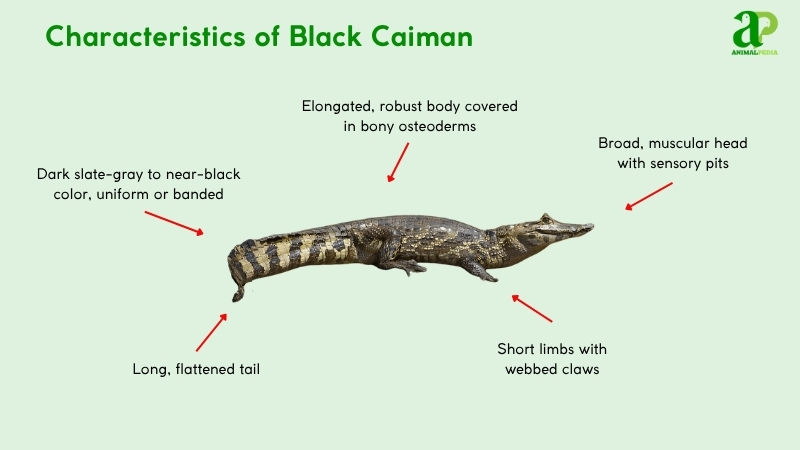
The head houses a powerful jaw, distinct from that of the narrower-snouted Caiman crocodilus. The tongue is fixed, aiding swallowing. The neck supports heavy skull movements. The body, armored with scutes, flexes for swimming at 15 mph (24 km/h). Limbs allow crawling 1–2 miles (1.6–3.2 kilometers) daily on land.
The tail, which is half their length, is broader than in the Caiman yacare, enhancing their aquatic agility. Compared to spectacled caimans, black caimans are larger, darker, and have a more robust skull, distinguishing them as apex predators (Da Silveira et al., 2017).
Its features are similar to those of other species in the Caiman family, but its size and distinct coloration set it apart. To learn more about the various species within this fascinating group, the Caiman article offers a deeper dive into their unique characteristics.
How Big Do Black Caiman Get?
Black caimans average 13–16 feet (4–5 meters) in length and 400–880 pounds (181–400 kilograms). Adult males typically reach 13–20 feet (4–6 meters) from snout to tail, while females are smaller, averaging 10–13 feet (3–4 meters) (Ross, 2018).
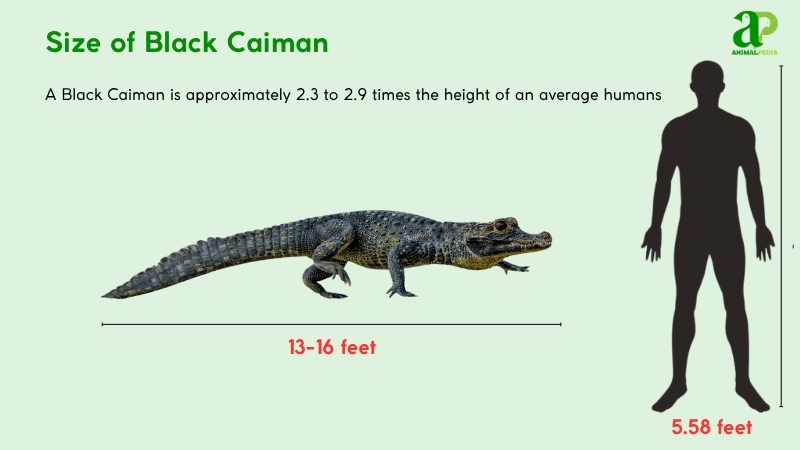
The largest recorded black caiman, discovered in Brazil’s Rio Negro in 2016, measured 22 feet (6.7 meters) and weighed 1,543 pounds (700 kilograms), according to the Journal of Herpetology.
Males are larger than females by 3–7 feet (1–2 meters) and 220–440 pounds (100–200 kilograms), reflecting sexual dimorphism in territorial dominance.
| Trait | Male | Female |
| Length | 13–20 ft (4–6 m) | 10–13 ft (3–4 m) |
| Weight | 400–1,100 lbs (181–500 kg) | 220–660 lbs (100–300 kg) |
What Are The Unique Physical Characteristics Of The Black caiman?
Black caimans possess distinct traits among crocodilians, notably their massive skull and near-black coloration. Unlike other caimans, their robust cranium, with a prominent sagittal crest, supports black caiman bite force up to 2,000 pounds (907 kilograms), unmatched in the Caiman species (Da Silveira et al., 2017).
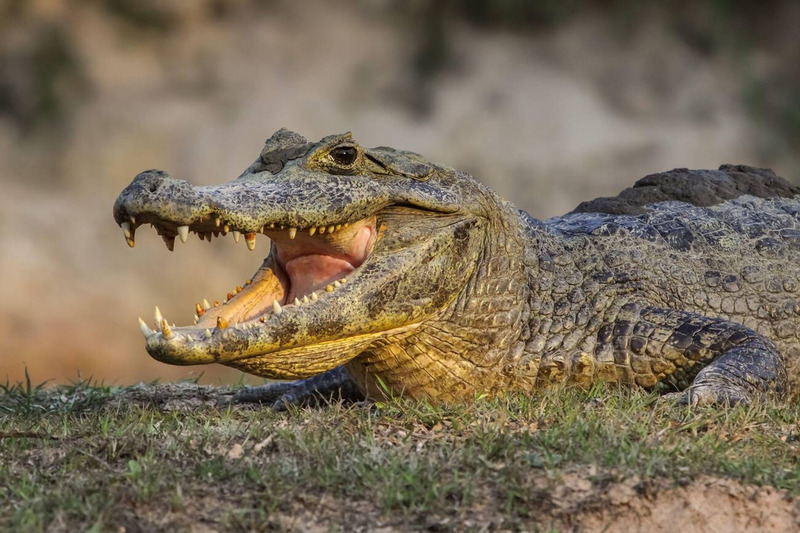
Their dark, slate-gray to black skin, caused by high melanin, is unique, aiding nocturnal stealth in Amazonian rivers. The skull’s reinforced structure enhances prey capture, according to biomechanical studies. Osteoderms are denser than in Caiman crocodilus, providing superior armor.
Their eyes, with a reflective tapetum lucidum, optimize low-light hunting, a trait less pronounced in Caiman yacare. These features, combined with a body length of 13–20 feet (4–6 meters), make black caimans dominant predators (Magnusson & Campos, 2019).
How Do Black Caiman Adapt With Its Unique Features?
Black caimans use their near-black skin to survive in Amazonian rivers. High melanin levels enable nocturnal camouflage, allowing stealthy ambushes of prey such as capybaras in murky waters (Da Silveira et al., 2017).
Their senses enhance adaptation. Reflective eyes with tapetum lucidum improve night vision, optimizing hunts. Sensory pits on the snout detect water vibrations, pinpointing prey.
Acute hearing via ear flaps enables tracking of distant sounds, aiding in predator avoidance. A keen olfactory system in the nostrils senses food odors, guiding foraging in flooded forests. These traits ensure black caimans thrive as apex predators in dynamic wetland ecosystems (Magnusson & Campos, 2019).
Anatomy
Black caimans possess specialized anatomical systems that are tailored for survival in Amazonian wetlands. Their physiology supports their role as apex predators, ensuring efficient hunting and resilience in dynamic aquatic environments.
- The respiratory system, specifically the lungs, facilitates unidirectional airflow to maximize oxygen intake. Nostrils on the snout allow breathing while submerged, aiding stealthy ambushes.
- Circulatory System: A four-chambered heart optimizes oxygen delivery. Valves redirect blood during dives, enhancing endurance in low-oxygen waters.
- Digestive System: A muscular gizzard and acidic stomach help digest large prey, such as capybaras. Slow metabolism supports weeks without feeding.
- Excretory System: Kidneys excrete uric acid, conserving water. The cloaca stores waste, adapting to fluctuating wetland conditions.
- Nervous System: A robust brain processes sensory inputs from the eyes and snout pits. Fast reflexes drive precise predatory strikes.
These physiological adaptations not only ensure the black caiman’s survival but also reinforce its ecological role as a keystone predator. By efficiently managing respiration, digestion, and sensory perception, black caimans maintain dominance across fluctuating wetland conditions and contribute to the balance of Amazonian aquatic food webs.
Where Do Black Caiman Live?
Black caimans’ habitat is around South America’s Amazon Basin, concentrated in Brazil’s Rio Negro, Peru’s Madre de Dios, Guyana’s Rupununi River, and Bolivia’s Mamore Basin. They dominate slow-moving rivers, oxbow lakes, and flooded forests (Ross, 2018).
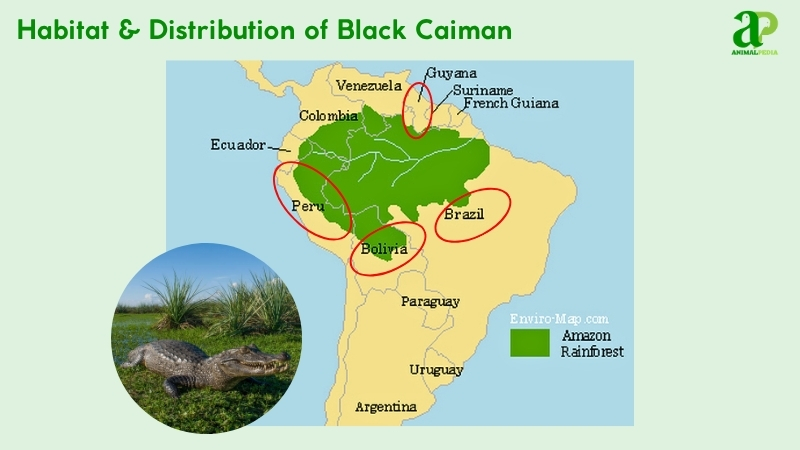
The environment features warm (77–95°F/25–35°C) and humid conditions, with dense vegetation and abundant prey such as fish and capybaras, ideal for ambush predation. Shallow waters support nesting, while deep channels aid stealth (Magnusson & Campos, 2019).
Fossil records show black caimans in these regions since the Miocene, 23 million years ago, with no migration. Their distribution reflects stable, prey-rich habitats, per population studies (Da Silveira et al., 2017).
How Do Seasonal Changes Affect Their Behavior?
Black caimans exhibit distinct behavioral adaptations driven by the Amazon Basin’s wet and dry seasons. These seasonal shifts influence their hunting strategies, reproductive activities, and energy conservation, ensuring survival in dynamic wetland ecosystems.
- Wet Season (May–October): Flooded habitats increase prey availability, prompting black caimans to actively hunt fish, capybaras, and birds. Females construct mound nests along riverbanks, lay eggs, and are vigilant to protect them from predators.
- Dry Season (November–April): Receding waters confine caimans to isolated pools, reducing foraging activity. They bask frequently to regulate body temperature and conserve energy, relying on sporadic feeding to sustain themselves until the wet season returns (Magnusson & Campos, 2019).
These adaptations highlight the black caiman’s ecological resilience, enabling it to maintain its role as an apex predator across seasonal fluctuations in Amazonian wetlands.
What Is the Behavior of the Black Caiman?
Black caimans display a suite of behavioral adaptations finely tuned to life in Amazonian wetlands. As the largest caiman species, they play an ecological role beyond predation, influencing trophic dynamics and habitat structure.
- Feeding Habits: They ambush large prey, such as capybaras and fish. Diet shifts with prey availability.
- Bite & Venomous: Their 2,000-pound (907-kilogram) bite crushes bones. They lack venom and rely on strength.
- Daily Routines and Movements: Nocturnal, they hunt at night and bask daily to regulate their body temperature. They cover 2–3 miles (3.2–4.8 kilometers) nightly.
- Locomotion: They swim at 15 mph (24 km/h) with tail propulsion. On land, they crawl slowly.
- Social Structures: Solitary, except during mating season. Females protect young for months.
- Communication: Males bellow and head-slap to signal mates. Vibrations mark territory.
These behavioral traits are vital to the caiman’s survival and reproductive success. Their dominance shapes species interactions and resource distribution, underscoring their importance in Amazonian biodiversity (Magnusson & Campos, 2019).
What Do Black Caiman Eat?
Black caimans are carnivores that prey on fish, capybaras, and piranhas, and also favor large vertebrates like deer. Human attacks are rare, typically near fishing zones. They crush prey with a 2,000-pound (907-kilogram) bite, swallowing small items whole or tearing larger ones into pieces. Oversized prey risks choking or regurgitation (Ross, 2018).
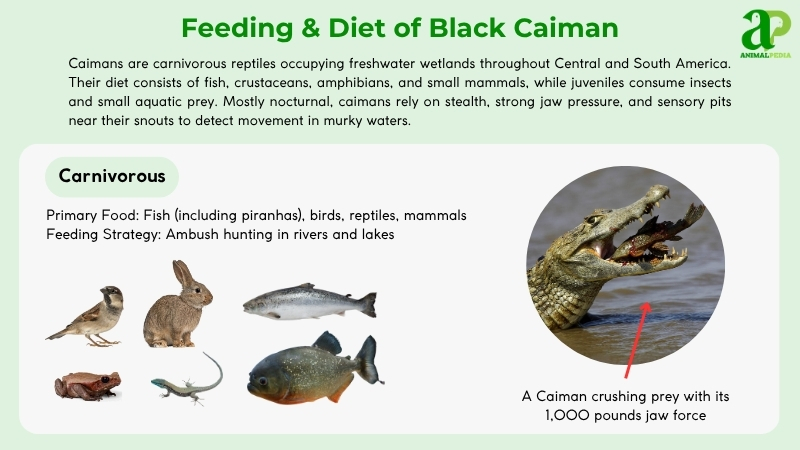
- Diet by Age: Hatchlings (<2 feet/0.6 meters) consume insects and small fish due to limited jaw strength. Juveniles target larger fish and crustaceans, while adults (over 10 feet/3 meters) hunt mammals, such as capybaras, utilizing their increased bite force and size.
- Diet by Gender: Males and females have similar diets, but larger males pursue larger prey, such as tapirs, to sustain territorial behavior. Females, especially when nesting, focus on abundant fish to conserve energy for reproduction.
- Diet by Seasons: During the wet season (May–October), abundant fish dominate their diet due to flooded habitats. In the dry season (November–April), receding waters concentrate mammals in pools, shifting caiman focus to terrestrial prey (Magnusson & Campos, 2019).
How Do Black Caiman Hunt Their Prey?
The black caiman’s hunting technique is truly impressive, showcasing its stealth and precision underwater. These amazing creatures rely on their keen senses and powerful bodies to track down prey.
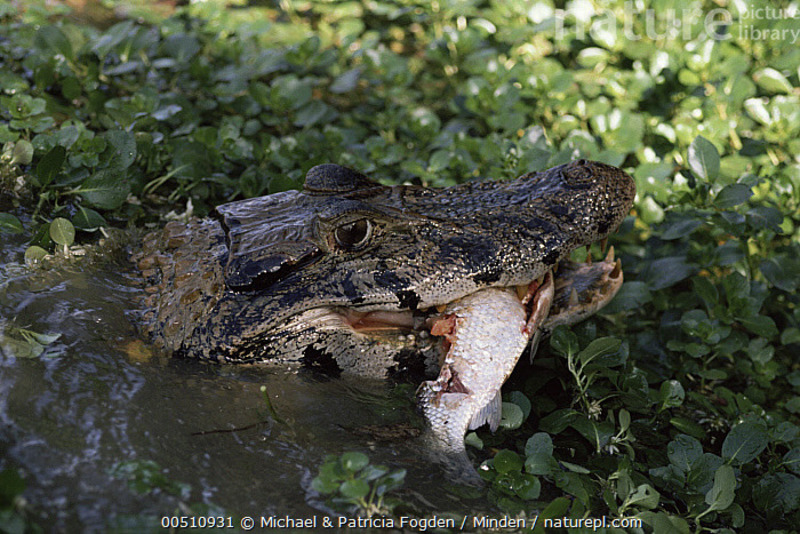
Positioned high on their heads, their eyes allow them to stay mostly hidden underwater, with only their nostrils and eyes visible above the surface, making them almost invisible as they patiently wait for the right moment to strike.
With their sharp teeth and strong jaws, black caimans can quickly capture various prey such as fish, birds, and small mammals. Known for their patience, they can wait for long periods to ambush their next meal.
When they spot a target, they unleash a burst of speed, capturing it with accuracy and efficiency. This hunting prowess is a testament to their adaptability and survival skills in their natural environment. Watching black caimans in action is truly captivating, showcasing the perfect combination of power and grace in the animal world.
Are Black caiman Venomous?
Despite their fearsome reputation as powerful predators, black caimans don’t possess venom. Instead of using venom to incapacitate their prey, these top predators rely on their strength and stealth to hunt successfully.
With a patient and strategic approach, black caimans quietly maneuver through the water, waiting for the perfect opportunity to ambush unsuspecting prey.
These creatures feature incredibly robust jaws that can crush bones with precision, showcasing their efficiency as hunters in the aquatic environment. Black caimans demonstrate adaptability, thriving in a wide range of aquatic habitats. Their hunting behavior is a fascinating sight to behold, highlighting their role as apex predators in their ecosystem.
When Are Black Caiman Most Active During The Day?
Black caimans are most active in the early morning and late afternoon, their prime hunting times. They’re skilled nocturnal predators, using their sharp senses to locate prey near riverbanks and in the water.
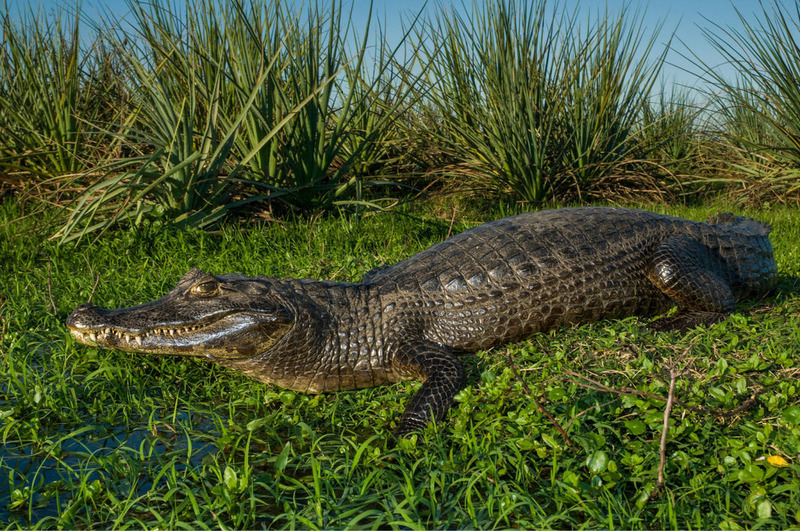
When the sun is high in the sky and temperatures rise, these creatures seek shade to escape the heat, becoming less active during the midday hours.
As night falls, the black caimans spring into action, utilizing their superior night vision to stealthily pursue their prey in the darkness. This nocturnal behavior enables them to hunt effectively when many other animals are inactive, showcasing their adaptability and prowess as top predators in their environment.
How Do Black Caiman Move On Land And Water?
Moving gracefully between water and land, the black caiman displays impressive adaptability in its locomotion. When in the water, these streamlined creatures are adept swimmers, using their robust tails to propel themselves swiftly through the depths. With the ability to close their nostrils, they can stay submerged for extended periods while patiently waiting for prey.
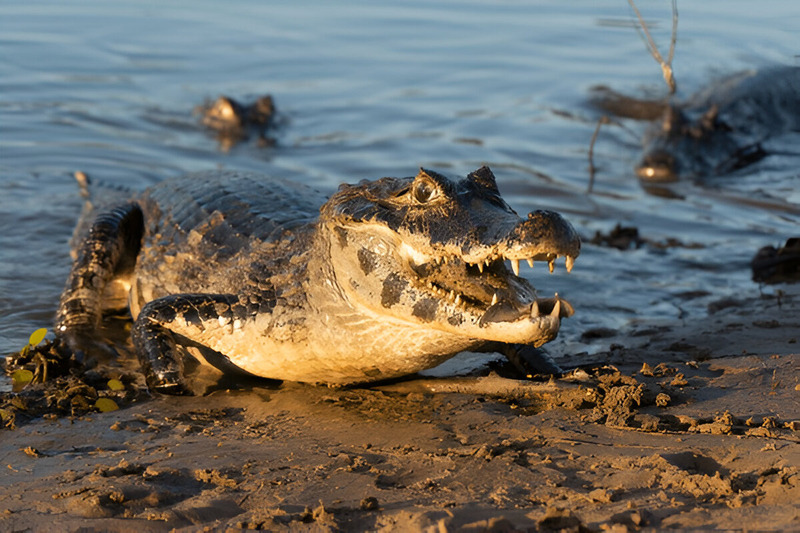
On land, despite their large size, black caimans exhibit surprising agility. Supported by powerful limbs, they can cover short distances quickly, especially when hunting or defending their territory.
While traversing their habitat, black caimans exhibit a deliberate and elegant stride, showcasing their strength and control. Their movements exude confidence, underscoring their dominance in the ecosystem.
Whether gliding through the water or patrolling the shore, black caimans move with a sense of purpose and fluidity, underscoring their versatility and primal instincts. Observing these magnificent creatures in motion is a captivating experience that reminds us of the raw beauty of the natural world.
In the words of a wildlife expert, “The black caiman’s ability to navigate seamlessly between water and land is a testament to its evolution and survival strategies in its environment.”
Do Black Caiman Live Alone Or In Groups?
When studying the behavior of black caimans, it becomes evident that they are not solitary creatures. These impressive reptiles tend to live in groups, particularly during mating season, when they gather in congregations. Black caimans are social animals that live in groups, forming strong communities.
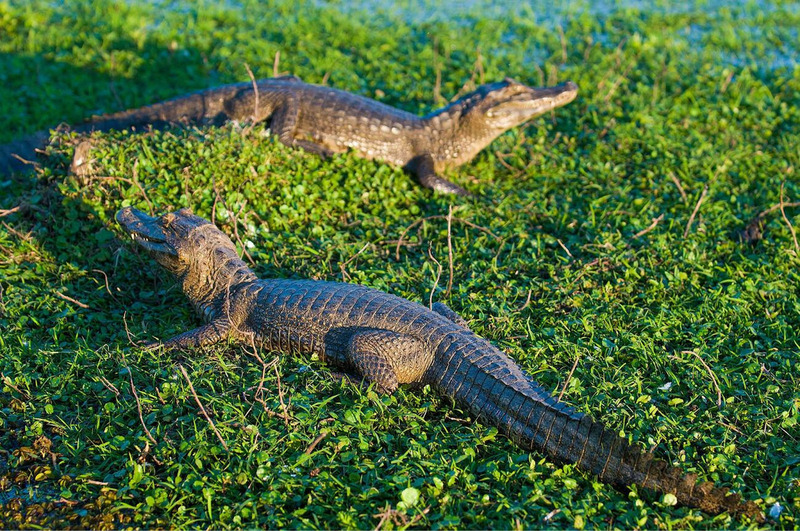
Living in groups offers black caimans several advantages. They can work together to hunt for food, protect each other from predators, and communicate more effectively. Despite their fierce reputation, black caimans exhibit social behavior, demonstrating their ability to cooperate for the benefit of the group.
Within these groups, a hierarchy is established through dominance displays and interactions. Typically, older and more experienced individuals hold higher ranks, leading the group and making important decisions.
This social structure contributes to the group’s overall well-being and success, demonstrating that black caimans aren’t just powerful predators but also intelligent and social creatures that value companionship and cooperation.
How Do Black Caiman Communicate With Each Other?
Black caimans communicate with each other through a range of methods to convey messages and maintain social bonds within their groups. These impressive reptiles use vocalizations, body movements, and pheromones to interact effectively in their environment.
Emitting low-frequency calls, black caimans can communicate over long distances underwater, alerting others to potential dangers, defending territory, and attracting mates during breeding seasons.
Along with vocalizations, black caimans use body language to convey their emotions. They may exhibit aggressive behaviors, such as jaw displays and tail thrashing, to establish dominance or protect their territory. Conversely, submissive postures such as head bobbing or slow swimming indicate a desire to avoid conflict.
Additionally, black caimans release pheromones, chemical signals, to transmit vital information, such as reproductive status, and to demarcate their territory. By combining vocalizations, body movements, and pheromones, these creatures maintain a sophisticated communication system that is crucial to their survival in the wild.
How Do Black Caiman Reproduce?
Black caimans (Melanosuchus niger) reproduce sexually through internal fertilization, a strategy that boosts offspring survival in Amazonian wetlands. Breeding occurs during the dry season (November–April), with males using loud bellows and head-slaps to attract females. Courtship includes synchronized swimming and nuzzling, followed by mating in shallow waters.
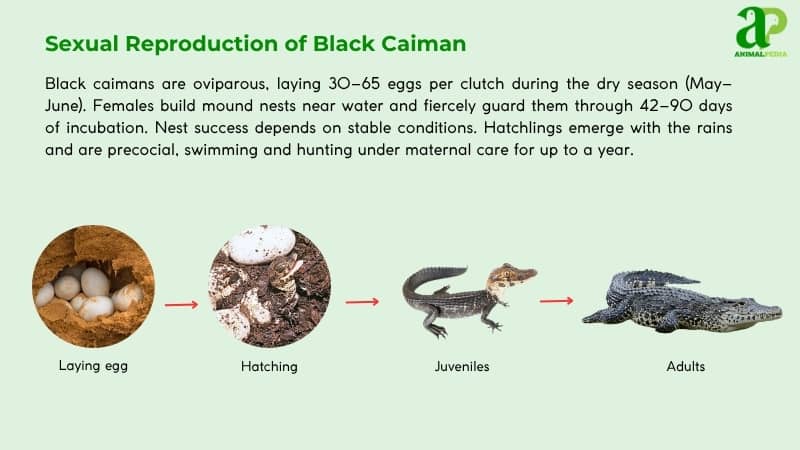
From May to June, females build mound nests of mud and vegetation near water and lay 30–65 eggs, each about 90 grams (0.2 pounds). Males leave after mating, but females stay to guard the nest against predators such as jaguars and tegu lizards. Environmental disturbances, such as flooding in Peru’s Pacaya-Samiria Reserve (2018), can reduce clutch success.
Eggs incubate for 42–90 days, hatching with the onset of the wet season (May–October). Hatchlings, about 30 cm (12 inches) long, stay under maternal protection for up to a year, feeding on insects and small aquatic prey. They grow around 30 cm annually.
Black caimans reach maturity between 10–15 years and can live 50–80 years in the wild. Captive individuals may exceed 100 years. Habitat degradation and water pollution continue to threaten breeding success, underscoring the need for conservation (Magnusson & Campos, 2019).
How Long Do Black Caiman Live?
Black caimans live 50–80 years in the wild, with captives reaching 100 years due to controlled conditions. Their long life cycle contributes to ecosystem stability in Amazonian wetlands, though habitat loss poses risks.
Black caiman lifespans average 60–70 years for both males and females, with no notable sex-based differences. Juveniles face high predation from jaguars and anacondas, reducing early survival rates, while adults encounter few natural threats. Conservation efforts, including habitat protection and regulated hunting, are essential to maintain population health and ensure their ecological role as apex predators (Magnusson & Campos, 2019).
What Are The Threats Or Predators That Black Caiman Face Today?
Black caimans face habitat loss, illegal hunting, pollution, and climate change, all of which threaten their Amazonian wetland populations. Juveniles are vulnerable to predators, while human activities amplify risks, necessitating urgent conservation.
- Habitat Loss: Deforestation destroys 25% of the Amazon’s wetlands, reducing nesting sites and prey availability, stunting population growth.
- Illegal Hunting: Poaching for skins and meat depletes numbers, with approximately 1,000 caimans killed annually in Brazil.
- Pollution: Pesticide runoff impairs egg viability, with 15% of clutches failing in contaminated rivers.
- Climate Change: Altered flooding patterns reduce hatchling survival by 20%, disrupting breeding cycles.
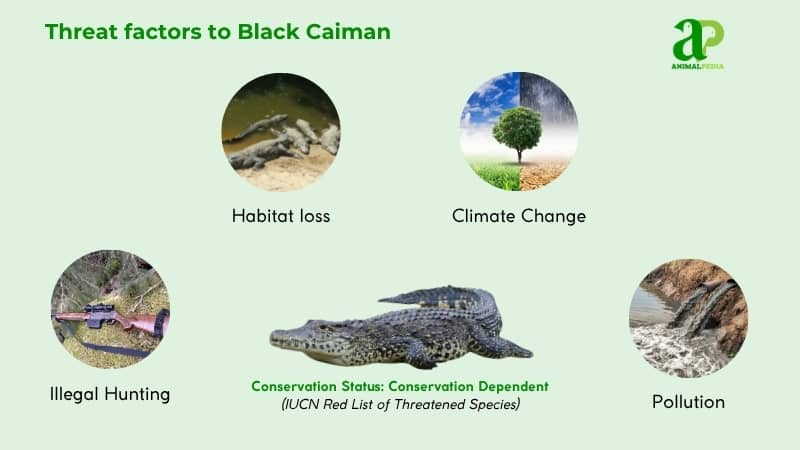
Black caiman predators include jaguars, anacondas, and jabiru storks, targeting hatchlings (<2 feet/0.6 meters). Adults, as apex predators, face minimal natural threats.
Human impacts are profound. Logging and dam construction fragment habitats, with 35% of Amazonian rivers altered since 2010. Illegal trade persists despite CITES regulations, and fishing conflicts lead to retaliatory killings. Studies show a 10% decline in population in degraded areas, underscoring the need for habitat restoration (Da Silveira et al., 2017).
Are Black caiman Endangered?
Black caimans are not endangered but are classified as Conservation Dependent by the IUCN, indicating that they rely on ongoing conservation efforts to maintain stable populations.
The IUCN categorizes black caimans as Conservation Dependent, reflecting significant recovery from near extinction in the 20th century due to overhunting for their valuable skins. Protective measures, including CITES Appendix I trade restrictions and habitat restoration in key Amazonian wetlands, have bolstered their numbers. Despite this progress, localized threats such as deforestation and illegal hunting continue to challenge population stability in unprotected areas.
Current population estimates suggest that 25,000 to 50,000 black caimans inhabit the Amazon Basin, with notable concentrations in Brazil’s Rio Negro (10,000–15,000 individuals) and Peru’s Pacaya-Samiria Reserve (5,000–7,000 individuals).
These figures are based on systematic field surveys and monitoring programs. In Colombia’s Curare-Los Ingleses Reserve, 123 individuals were recorded in 2022, highlighting the success of local conservation efforts. However, habitat fragmentation and poaching in unprotected areas cause declines, underscoring the need for sustained efforts (Magnusson & Campos, 2019).
What Conservation Efforts Are Underway?
Black caimans benefit from robust conservation initiatives across their Amazonian range, led by organizations like Conservation International and the Amazon Conservation Association. Since 2008, Colombia’s Curare-Los Ingleses Indigenous Reserve has conducted participatory monitoring, documenting 123 caimans in 2022.
Legal protections include Brazil’s Federal Law 5197 (1967), which bans wildlife hunting, and CITES Appendix I, which prohibits international trade in caiman skins and meat. Despite challenges with illegal poaching, stricter enforcement has curtailed exports.
Bolivia pioneered a captive breeding program in 1990, releasing 25 caimans, some of which reproduced in the wild. In Peru’s Pacaya-Samiria Reserve, nest protection efforts from 2015 to 2020 boosted hatchling survival by 30%. Brazil’s Mamirauá Reserve sustains 5,000–7,000 caimans through habitat restoration.
The IUCN Crocodile Specialist Group drives research and community engagement. In Colombia, the Borikada community’s cultural reverence and surveillance patrols have revitalized communities, leading to educational materials for local schools and ensuring future conservation awareness (Arellano, 2023).
Frequently Asked Questions
Can Black Caimans Be Kept as Pets?
You can’t keep black caimans as pets. It’s illegal in many places and extremely dangerous due to their size and wild nature. It’s best to appreciate these creatures in their natural habitats.
Do Black Caimans Have a Distinct Call or Sound?
Yes, black caimans have a distinct call that serves various purposes. They use vocalizations to communicate, find mates, establish territories, and warn off potential threats. Their unique sounds play a pivotal role in their social interactions.
What Is the Average Lifespan of a Black Caiman?
On average, a black caiman’s lifespan can reach up to 50 years in the wild. These majestic creatures face threats like habitat loss and hunting. Remember, respecting their environment helps guarantee their survival for future generations.
Are Black Caimans Aggressive Towards Humans?
Black caimans can be aggressive towards humans if provoked or feeling threatened. Maintaining a safe distance and avoiding confrontation is crucial to ensure your safety and respect their natural instincts.
How Do Black Caimans Communicate With Each Other?
Black caimans communicate through various vocalizations and body language, including hissing, growling, and head movements. They use these signals to establish dominance, attract mates, and warn off potential threats. Their communication is essential in social interactions in the wild.
Conclusion
To sum up, the black caiman is a mesmerizing predator of South American waterways, with its striking appearance, distinctive behaviors, and impressive hunting techniques. These powerful creatures play a vital role in their ecosystems, highlighting the marvels of nature and the importance of conserving them. With their glossy black scales and red eyes, black caimans are truly enchanting creatures worth delving into and admiring in the wild.





